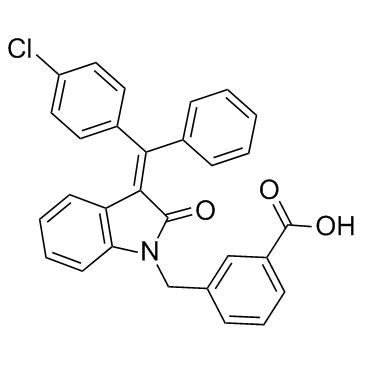| DC74251 |
BI-9774
|
BI-9774 (BI 9774) is a potent pan-AMPK activator with EC50 of 64 nM in an ADP-Glo kinase assay with human AMPK (α1β1γ1) and EC50 of 8 nM in a cellular GLUT4 translocation assay. |
| DC72738 |
YLF-466D
|
YLF-466D is an AMPK activator that inhibits platelet aggregation with IC50 of 84 μM. |
| DC71255 |
MOTS-c
|
MOTS-c, a mitochondria-derived peptide (MDP), exerts antinociceptive and anti-inflammatory effects through activating AMPK pathway and inhibiting MAP kinases-c-fos signaling pathway. |
| DC40041 |
RSVA405
|
RSVA405 is a potent, orally active activator of AMPK, with an EC50 of 1 μM. RSVA405 facilitates CaMKKβ-dependent activation of AMPK, inhibits mTOR, and promotes autophagy to increase Aβ degradation. RSVA405 has anti-inflammatory effects through the inhibition of STAT3 function. RSVA405 also can be used for the research of obesity. |
| DC39091 |
IM156
|
IM156, a metformin derivative, is a potent activator of AMPK that increases AMPK phosphorylation. IM156 blocks oxidative phosphorylation (OXPHOS) through the inhibition of complex I and increases apoptosis. IM156 ameliorates various types of fibrosis and |
| DC29234 |
GSK621 (GSK 621;GSK-621)
|
GSK621 (GSK-621) is a potent, specific AMPK agonist (activator), induces cytotoxicity in AML (IC50=13-30 uM) but not in normal hematopoietic cells; GSK621 is more potent than A-769662 at inducing AMPK activation, as measured by the level of ACC phosphoryl |
| DC12020 |
MK-8722
|
MK-8722 is a systemic, Direct Pan-Activator of AMP-Activated Protein Kinase. |
| DC10978 |
BAY-3827
|
BAY-3827 (BAY3827) is a potent, selective inhibitor of AMPK as tool compound to evaluate the therapeutic potential of AMPK inhibition in MYC-dependent tumors; strongly inhibits Acetyl-CoA carboxylase (ACC) phosphorylation in COLO 320DM and IMR-32 cells, but fails to inhibit the proliferation of cells with dysregulated c-MYC or N-MYC. |
| DC11129 |
AMPK activator SC4
|
AMPK activator SC4 is a highly specific and potent activator of the α2β2-AMPK complexes, which are the predominant AMPK isoform complexes found in human skeletal muscle. SC4 demonstrates significant efficacy with EC50 values of 17.2 nM for the α2β2γ1 complex and 82.1 nM for the α2β2γ3 complex. These low EC50 values indicate that SC4 is effective at relatively low concentrations, making it a promising compound for targeting AMPK in skeletal muscle. This specificity and potency suggest potential therapeutic applications in conditions where AMPK activation is beneficial, such as metabolic disorders, muscle function, and energy homeostasis. |






















